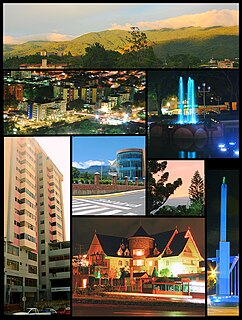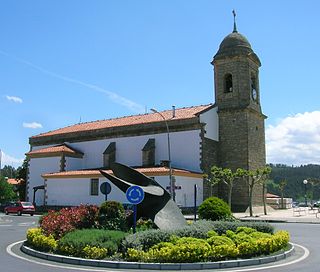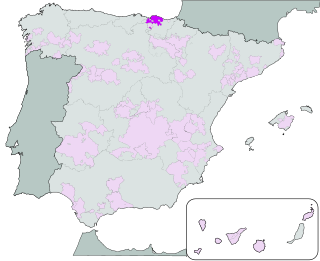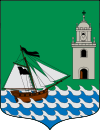
Bilbao is a city in northern Spain, the largest city in the province of Biscay and in the Basque Country as a whole. It is also the largest city proper in northern Spain. Bilbao is the tenth largest city in Spain, with a population of 345,141 as of 2015. The Bilbao metropolitan area has 1,037,847 inhabitants, making it one of the most populous metropolitan areas in northern Spain; with a population of 875,552 the comarca of Greater Bilbao is the fifth-largest urban area in Spain. Bilbao is also the main urban area in what is defined as the Greater Basque region.

San Cristóbal is the capital city of the Venezuelan state of Táchira. It is located in a mountainous region of Western Venezuela. The city is situated 818 metres (2,684 ft) above sea level in the northern Andes overlooking the Torbes River, 56 kilometres (35 mi) from the Colombian border. San Cristóbal was founded on March 31, 1561, by Juan de Maldonado. From its inception, the city evolved rapidly as one of the most progressive and important centers of commerce in the country, due primarily to its rich soil and its proximity to the border with Colombia.

Gipuzkoa is a province of Spain and a historical territory of the autonomous community of the Basque Country. Its capital city is Donostia-San Sebastián. Gipuzkoa shares borders with the French department of Pyrénées-Atlantiques at the northeast, with the province and autonomous community of Navarre at east, Biscay at west, Álava at southwest and the Bay of Biscay to its north. It is located at the easternmost extreme of the Cantabric Sea, in the Bay of Biscay. It has 66 kilometres of coast land.

Zarautz is a coastal town located in central Gipuzkoa, in Spain. It is bordered by Aia to the east and the south and Getaria to the west. It has four enclaves limiting the aforementioned municipalities: Alkortiaga, Ekano, Sola, and Arbestain. It's located about 15 kilometres (9.3 mi) west of San Sebastián. As of 2014, Zarautz has a population of 22,890, which usually swells to about 60,000 in the summer.

Bermeo is a town and municipality in the comarca of Busturialdea. It is in the province of Biscay, which is part of the autonomous region of the Basque Country in northern Spain.

Erandio is a town and municipality located in the province of Biscay, in the autonomous community of Basque Country, northern Spain.

Getxo is a town located in the province of Biscay, in the autonomous community of the Basque Country, in Spain. It is part of Greater Bilbao, and has 77,946 inhabitants (2019). Getxo is mostly an affluent residential area, as well as being the third largest municipality of Biscay.

Gorliz is a town and municipality located in the province of Biscay, which lies within the autonomous community of the Basque Country, in northern Spain. The town had 5,664 inhabitants in 2014.

Mundaka is a town and municipality located in the province of Biscay, in the autonomous community of Basque Country, northern Spain. On the coast, Mundaka is internationally renowned for its surfing scene.

Sopela, also known as Sopelana, is a town and municipality located in the province of Biscay, in the autonomous community of Basque Country, northern Spain. The town is roughly 820 hectares in area, located in the comarca Mungialdea on the north east side of Bilbao and due east of the Nervión river estuary. In the municipality, other former towns like Larrabasterra are now merged to make Sopela larger. The population is 13,878 people, as recorded in the 2019 census. The area of Sopela is situated among green hills and beaches. This makes it a very attractive suburb of Bilbao, with a short commute of 35 minutes on the metro.

Getaria is a coastal town located in the province of Gipuzkoa, in the autonomous community of Basque Country, in the North of Spain. This coastal village is located on the Urola Coast, with Zarautz to the east and Zumaia to the west.

Santutxu is a neighbourhood of the Spanish city of Bilbao. It belongs to the 4th urban district, named Begoña. It is a popular residential neighbourhood which has a significant number of small businesses and has received some waves of immigration in the last years, particularly Romanians. The Begoña district consists of three neighbourhoods: Santutxu, Begoña and Bolueta.

Mount Oiz, is one of the most popular summits of Biscay in the Basque Country (Spain). Its summits form part of a long range that feeds several rivers: Ibaizabal, Artibai, Lea, Oka and Deba in Gipuzkoa all of them running to the Bay of Biscay.

The Urdaibai estuary is a natural region and a Biosphere Reserve of Biscay, Basque Country, Spain. It is also referred as Mundaka or Gernika estuary.

Txakoli de Bizkaia – Bizkaiko Txakolina is a Spanish Denominación de Origen Protegida (DOP) for wines, located in the province of Bizkaia, Basque Country, Spain. The DOP includes vineyards from 82 different municipalities.

Bilbao-Atxuri is a former terminal railway station in Bilbao, Basque Country (Spain). It served as the terminus station for the commuter rail trains of Euskotren Trena lines to Durango, Bermeo, Eibar and Donostia for over one hundred years.

Zazpikaleak/Casco Viejo is a railway station in Bilbao, Basque Country (Spain). It is located in the historical neighbourhood of Casco Viejo, in the district of Ibaiondo. It connects the rapid transit network of Metro Bilbao with the commuter rail services of Euskotren Trena. It is the main hub of railway connection between the metropolitan underground network and the railway services to Eibar, Gernika, Bermeo and San Sebastián as well as the Txorierri valley. In its current form, the station opened on 8 April 2017.

The Church of San Antón is a Catholic temple located in the Old Town neighbourhood of Bilbao, Spain. It is dedicated to Anthony the Great, known as San Antón in Spanish. It is featured, along with the San Antón Bridge, in the city's coat of arms. The estuary of Bilbao flows next to it.
Tourism in the Basque Autonomous Community has increased considerably in recent years. According to data from the Eustat the number of tourists entering the region in the year 2009 was 1,991,790, a figure which has improved over 2010, with the final result still pending. Of the people who visit the region each year, 71% come from the rest of Spain, with the following Autonomous Communities providing the greatest number of visitors: Madrid Autonomous Community (14.2%), Catalonia (11.1%). International visitors make up the remaining 29%, with France (7.2%) being the country which provides the most visitors to the Basque Autonomous Community. Furthermore, 62% of the people who come to the Basque Autonomous Community visit one of the three capitals, 27% visit inland and 11% the Basque Autonomous Community coast. The average stay of the visitors is 1.88 days, with Gipuzkoa being the province which records the longest stays, with an average of 2.01 days.
Ibilaldia meaning trip, journey, or march in English is a festival organized every year the last Sunday of May or first of June to help the ikastolak in Biscay, Basque Country in Spain.
























